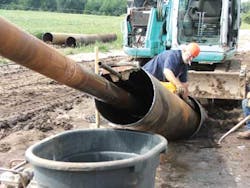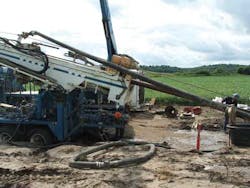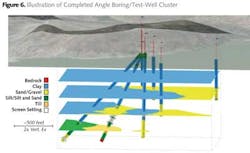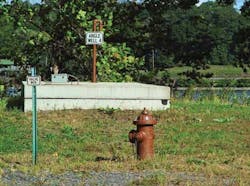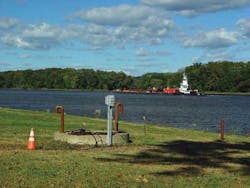Well and Good: After "Easy" Water Has Been Tapped, Unconventional Wells Offer Innovative Solutions
By Frank Getchell, Martha Silks, and Douglas Hunter
Developing an innovative strategy for a particular atypical groundwater resource application requires purveyors and engineers alike to think unconventionally and beyond the traditional vertical well. A horizontal well, collector well or angle well may be the most cost-effective alternative when all construction options and site variables are considered, including hydrogeology, capital and maintenance costs as well as regulatory issues.
A horizontal well consists of either an angled or vertical entry into the subsurface that eventually becomes orientated horizontally as it passes through the surrounding aquifer. Depending on site conditions, the horizontally-orientated borehole may extend back out of the aquifer and return to the surface at a pre-identified distance from its entry, or it may end in the targeted formation.
Current drilling technology enables horizontal screens to extend for up to several hundred feet into the targeted aquifer. When the aquifer is relatively shallow, the horizontal well may sometimes be constructed using standard excavation and shoring equipment and configured as an infiltration gallery. Likewise, horizontal well configurations are often considered when the aquifer is too thin for a vertical well or too deep for advancement of a vertical collector well caisson, yet laterally extensive enough to serve as a reliable groundwater supply.
A collector well consists of a vertical concrete caisson with one or more horizontal lateral well screens projected into the surrounding aquifer, often in a radial pattern. Multiple horizontal laterals are typically installed to project from the caisson at either the same or varying elevations, with individual lateral screens extending up to 200 feet out from the caisson. As water demand increases, the capacity of an existing collector well may be increased through the installation of additional laterals. Collector wells are often considered for use where the aquifer is relatively thin and/or potentially recharged by surface-water sources. They may also be used to extend into the portion of an aquifer underlying a surface-water body to utilize the recharge potential using more than one screen - an inherent limitation of horizontal and angle well installations under similar hydrogeologic conditions.
An angle well consists of a steel casing driven at an optimal angle between 20 to 45 degrees from the horizontal, which is used to set a screen remotely from the point of subsurface entry. The screen can be set several hundred feet away and have a length of around 100 feet or less. In a sense, the angle well is something of an amalgam between the vertical well and the collector well. Angle wells have been used for some time in the petroleum and gas industry, and they are gaining acceptance in the water industry as the potential advantages are acknowledged.
Because horizontal, collector and angle wells generally require considerably less land area than a comparable field of vertical wells - and can often provide significantly higher yields - they may be attractive alternatives where land is limited or expensive to acquire. In addition, all three types of non-vertical wells are inherently more efficient than the vertical counterparts.
Avoiding Surface-Water Influence
A potentially advantageous site for any of these well types is adjacent to surface-water bodies, where induced infiltration and natural filtration through aquifer materials can produce abundant, reliable water with expected low turbidity and filtration of undesirable surface water constituents, including microorganisms. In the past, collector well laterals or angle well screens were often extended beneath surface-water bodies to maximize induced infiltration potential. However, some jurisdictions are re-designating these groundwater supplies as under the direct influence of surface water, which may require construction of a costly filtration and disinfection treatment plant or modification of the well to maintain its designation strictly as a groundwater source supply.
For example, LBG recently completed the redesign and re-permitting of a collector well, built in the 1950s that was designated by the local regulatory agency as under the direct influence of surface water because four of its five laterals did not meet the regulatory setback distance from an adjacent creek. A scope of work was negotiated with the regulatory agency intended to attain a groundwater source designation for the well. The four suspect laterals were properly abandoned, and testing and sampling of the well was performed using the single remaining lateral that ran parallel to, but not under, the creek.
The results qualified the well for re-designation as a groundwater source by the agency. As part of its approved approach, LBG conducted a test-drilling program to collect information necessary to design two new more efficient replacement laterals for the well and prepared bid specifications for their installation. The new laterals were successfully installed, and the well is meeting the city's needs for capacity under the groundwater designation.
Identifying the Optimal Alternative
Identifying the optimal alternative for an atypical aquifer requires an analysis of hydrogeology, understanding of capital and maintenance costs, determination of desired yields, and identification of regulatory issues and logistics for the site. Based on site and construction costs, the capital cost of an angle well may be triple that of a vertical well, and a collector well can easily be 15 to 20 times the cost of a vertical well. Due to the complexity of siting and designing a collector well, the project timeline is much longer than that of a horizontal and angle well or vertical well. However, as the total number of vertical wells that are required to produce the desired yield increases, so do the land availability requirements and capital costs of pumps, power and distribution pipelines; the same applies for maintenance over the lifecycle of the wells.
In some cases, the optimal solution may include development of groundwater and surface water components for the overall supply. For example, LBG performed a desktop study of regional and local hydrogeology to identify potential well-field sites for a municipal water authority in the Midwest that is interested in developing a new 20 MGD groundwater supply to reduce dependence on its surface water supply, especially during drought conditions. The study identified 17 potential well-field locations. Using available geologic and hydrogeologic information, the potential yield of a collector well at each of the 17 sites was calculated. As a follow-up, the potential yield was also calculated for a new surface-water intake at a local sand quarry which, if developable, would mitigate potential water use conflicts with a larger municipality. The results will be used to compare alternatives and select an optimal solution.
In another situation, LBG assessed the potential for developing a supplemental/ replacement groundwater supply of 2 to 3 MGD from a deep confined aquifer, underlying the lower freshwater portion of a major estuary in the Northeast. Due to land availability and local terrestrial aquifer recharge limitations, the interested municipality had limited remaining alternatives for the development of this supply. Based on exploratory barge-mounted drill-rig borings, the aquifer occurred beneath over 100 feet of highly plastic clay and thickened away from the shore and towards the estuary channel. Three angle-borings, converted to temporary test wells, were advanced from the shoreline where highly restrictive topography extended close to 500 feet toward the estuary channel and sloped to maximize penetration of the wedge-shaped aquifer. The preliminary results indicated potential individual well yields of 0.5 to 1 MGD. The results were used to design a full-scale angled test well capable of being converted to a permanent supply well if warranted, based on subsequent testing. Without the angle-well approach, this aquifer would not be accessible to vertical wells or a collector well due to its wedge-shaped configuration and significant overlying clay thickness.
As the challenges and costs associated with land acquisition, recharge limitations, source-water protection, and surface-water influence concerns increase, owners and engineers must think beyond conventional vertical well technologies to develop innovative and cost-effective solutions for their water supply needs. In these circumstances, horizontal, collector and angle wells may offer the most long-term and cost-effective alternative.
About the Authors: Frank Getchell has over 30 years of hydrogeologic consulting experience and is an AIPG-certified professional geologist and is licensed in Delaware, Maine, New Hampshire, North Carolina, and Pennsylvania. He provides expert testimony on groundwater resource development and contamination issues and is enlisted as a course instructor for national water-related professional organizations.
Martha Silks has 26 years of experience as a hydrogeologist in the siting, design and protection of water supply well fields. She specializes in groundwater exploration and subsurface investigations; well and well-field evaluation; and design of horizontal collector, horizontal directional-drilled, angle, and vertical wells. She is a professional geologist in Nebraska, Texas and Kansas.
Doug Hunter has more than 23 years of experience as a consulting hydrogeologist emphasizing groundwater flow investigations and characterizations; aquifer test analysis and interpretation; induced infiltration studies; groundwater supply development and management; and evaluation and design of horizontal collector well and vertical well systems. He is professionally licensed in North Carolina and Indiana.
